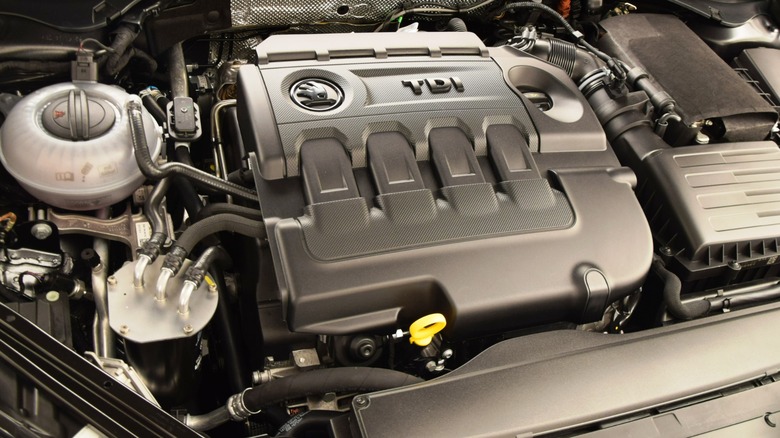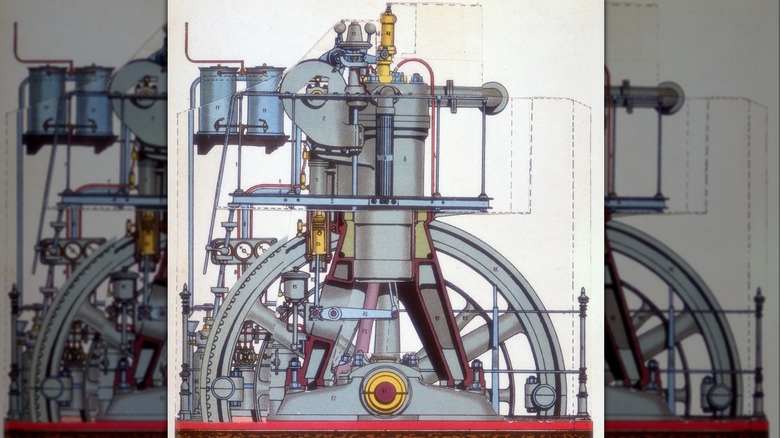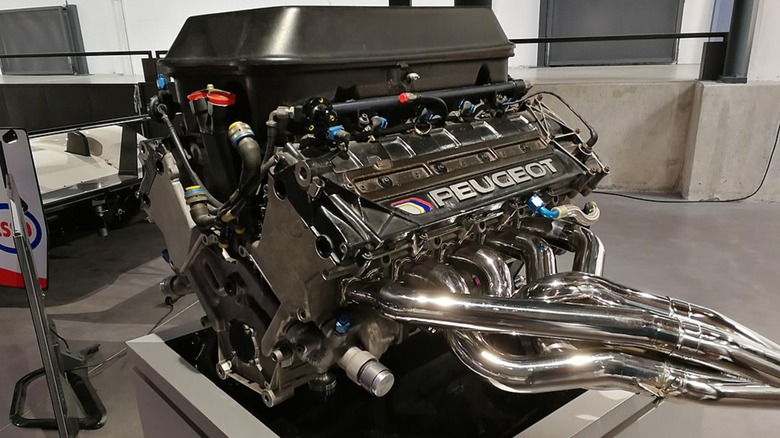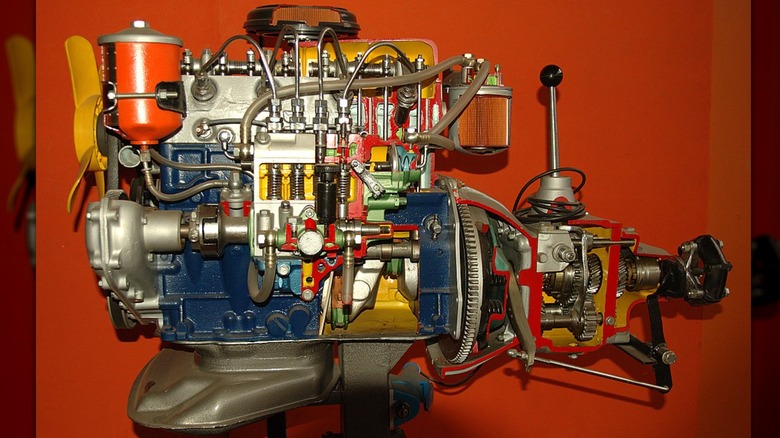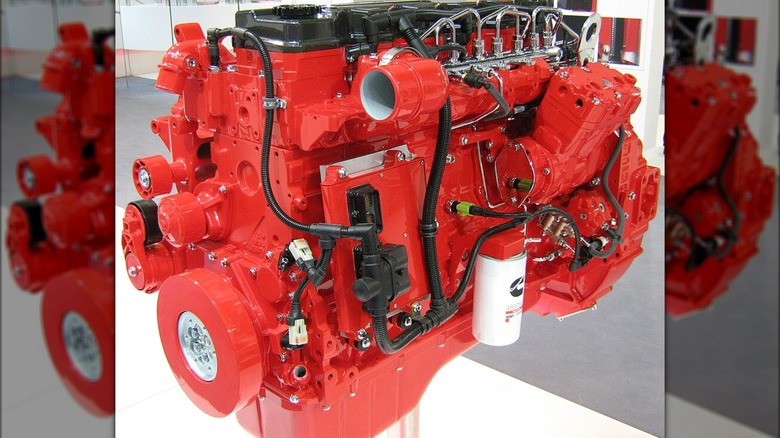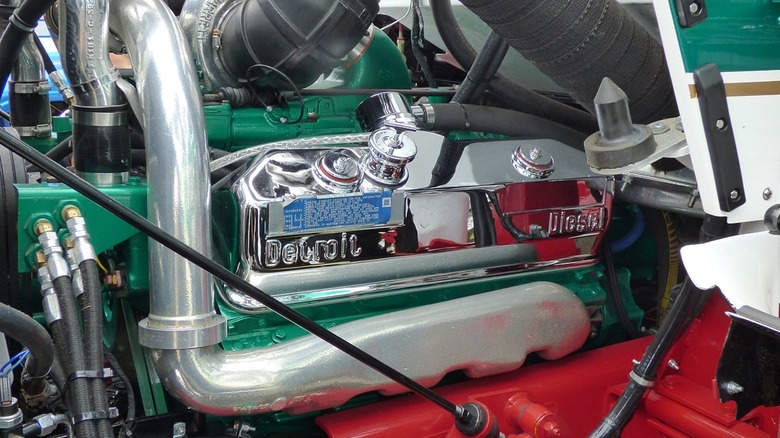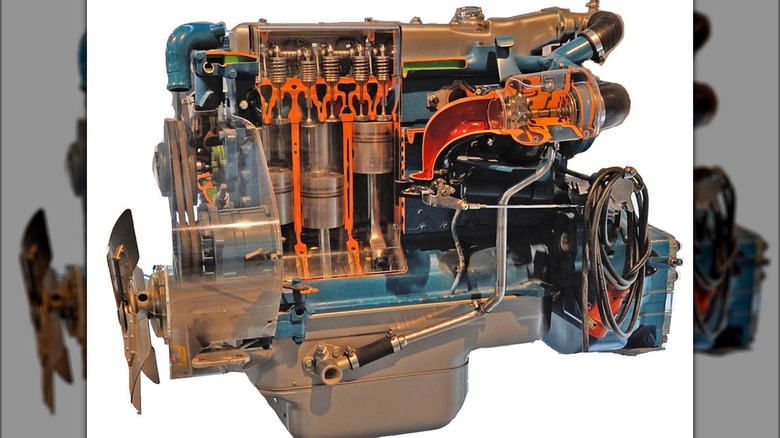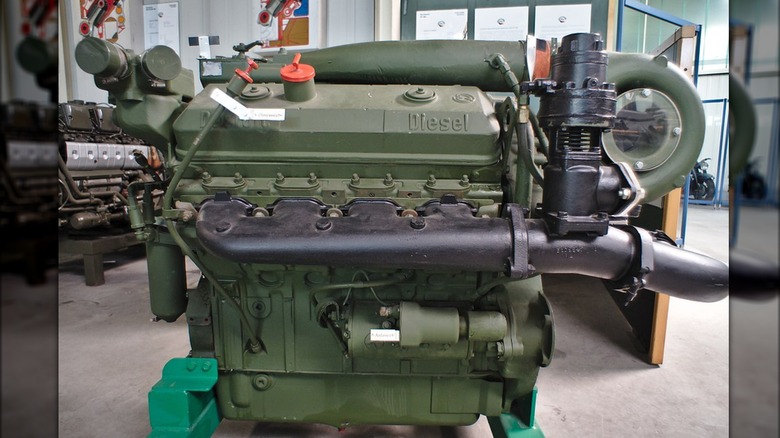Why Diesel Engines Are More Efficient Than Gas Explained
Internal combustion engines are literally the engines of the modern world. Without the invention of these genius mechanical creations, our world would be markedly different and the pace of life would be much slower. Accessible to almost anyone and inexpensively fueled by refined crude oil, the internal combustion engine provided a level of freedom for people to travel and work in almost any location, and the evolution of engines, and with them the modern world at large, proceeded quickly.
While a range of fuels were tested with the earliest of engine designs, gasoline eventually proved to have the most desirable properties for widespread use. It was relatively stable, abundant, and contained sufficient energy to be exploited. Most early engines relied on an operating process known as the four-stroke cycle developed by Nicolaus Otto, and his invention continues to be dominant today. While the first Otto cycle patent was filed in 1887, Rudolf Diesel developed an alternate cycle for use in an internal combustion engine, with his first patent filed in 1898. Diesel's engine design did not initially catch on, and gasoline engines dominated production in the first half of the century, even for heavy-duty applications. Diesel engines did not see widespread use until after WWI, and the proliferation of them in heavy-duty applications such as heavy trucks, tanks, and boats further accelerated after WWII.
Today, both engines are used in a wide variety of vehicles, with many automakers choosing diesel for its excellent energy efficiency. But what makes diesel engines more efficient, and why are they not installed in all cars? To answer that, here is an exploration of why diesel engines are more efficient than gasoline engines.
Internal combustion engines
The first practical engine invented that could be replicated and put into widespread use was the steam engine, created by James Watt in the 1770s. The steam engine is an example of an external combustion engine, so called because the combustion of fuel — wood or coal in this case — to raise the temperature of the water for steam occurred outside of the cylinder. It is only by the pressure of the externally heated steam that the piston can be made to move and transform the energy into motion. This engine design worked incredibly well, but only in large applications, keeping them confined to large machines running early factories and, of course, steam trains.
Engineers, inventors, and tinkerers began to experiment with ideas to make an internal combustion engine midway through the 19th century. This sort of engine introduces either a gas or an atomized mixture of liquid fuel and air into a combustion chamber where it can be lit, resulting in combustion within the cylinder to apply pressure to a piston, converting the energy into motion. People pursued experimentation with dozens of rudimentary designs at the time, particularly in the United States and Europe. The development of the Otto Cycle was a breakthrough and led to the proliferation of workshops vying to have the first practical engine design. This coincided with the development of the refining process that yields usable fuels from crude oil. The first person to put an internal combustion engine to use in a self-propelled vehicle that was reliable and practical was Karl Benz with his Patent Motorwagen in 1887.
How gasoline engines work
Fundamentally, a gasoline internal combustion engine (ICE) is an air compressor including an ignition source for fuel. To operate, an engine needs fuel with a sufficient quantity of oxygen to achieve combustion. This is achieved by drawing air and fuel into the cylinder and compressing it into a combustion chamber. At this point, a spark plug uses electricity to create a spark, igniting the fuel/air mixture. The expansion of the combustion gasses applies pressure, forcing the piston, which is connected to the crankshaft by the connecting rod, down the cylinder and turning the energy in the fuel into a rotational force.
The fuel/air mixture is metered by a carburetor or fuel injection and the flow into the cylinder is controlled by valves that open and close at specific intervals in relation to the rotating crankshaft. An intake valve allows in the mixture on the intake stroke, and it is then compressed on the compression stroke, the power stroke occurs when combustion begins, an exhaust valve opens as the piston returns to the top on the exhaust stroke, and then the four-stroke cycle begins again. The valves are opened by a shaft with eccentric lobes turning at a rate fixed to the crankshaft. Modern engines are controlled by a multitude of systems and accessories that could take up pages of writing to explain. However, the basics of the four strokes and their functions in transforming chemical energy into rotational force remain constant among all Otto cycle gasoline engines.
[Featured image by Axepas12 via Wikimedia Commons | Cropped and scaled | CC BY-SA 4.0]
How diesel engines work
Diesel engines are mostly similar to gasoline engines with the primary difference being how the fuel/air mixture is ignited. The components are mostly the same in that a diesel engine also has valves, a camshaft, pistons, crankshafts, etc. but diesel fuel is always introduced into the cylinders through fuel injection. Furthermore, a diesel engine does not require spark plugs.
When a gasoline engine compresses its fuel/air mixture, it does so at a ratio ranging from roughly 8:1 to 12:1, with some racing engines going a bit higher. This means an engine will compress what takes up, for example, 8 units of air (at surface level air pressure) into a space that normally holds only 1 part of air to achieve an 8:1 ratio. This ratio is called the engine's compression ratio. Diesel engines operate with much higher compression levels, ranging from 14:1 to 25:1. They take advantage of the phenomenon that occurs when air is highly compressed — it raises the temperature dramatically. Rudolf Diesel discovered that when air and the right fuel are compressed to a high enough level, combustion occurs spontaneously, and that was the basis for his engine cycle. The intake stroke of a diesel only draws in air, and once it is fully compressed, fuel is injected directly into the cylinder, initiating combustion. The same four strokes of the Otto cycle exist, but the method of combustion is altered. This description leaves out much of what goes into making a diesel engine tick as a whole, but these are the fundamentals of how every diesel engine operates.
Differences in construction
Gasoline and diesel engines are similar in many ways, but there are fundamental differences in how they are built, and this contributes greatly to the decision of which engine a manufacturer will choose for a given application. Diesel engines are much heavier because they require more raw materials to create, which adds to the cost of manufacturing. The ultra-high compression levels exert significant force in all directions, and the engine block, heads, and valves all have to be strong enough to withstand that pressure without cracking or coming apart. For this reason, the walls and the heads of a diesel engine block have to be much thicker. Furthermore, the pistons and connecting rods must be thicker, as do the crankshaft and main caps that keep it in place.
Gasoline engines use a throttle valve connected to the accelerator to regulate the amount of airflow entering the engine, and the carburetor or fuel injection system mixes in fuel according to the airflow. This makes gasoline fuel delivery systems relatively cheap and easy to produce at a basic level, while even basic diesel fuel injection systems are more complex and expensive. A diesel engine only regulates the amount of fuel entering the engine; the accelerator adjusts the amount of fuel being delivered to alter its speed. While spark plugs are not needed to ignite diesel fuel, the engines require some heat to facilitate combustion and have glow plugs that heat the combustion chambers before a cold start.
Power delivery
Both gasoline and diesel engines can be made to produce a tremendous amount of power but in different ways. Part of that has to do with how they function. Gasoline engines can be built to run at a high speed due in part to the lighter materials used to make them, creating less rotating mass within the engine. Diesels use heavy parts and run at a much lower RPM — redline for most diesels tops out under 5,000, while many four-cylinder gasoline engines can go faster than 8,000. This results in diesel engines that produce high levels of torque, while gasoline engines produce high levels of horsepower.
The torque rating describes an engine's capacity to do work while horsepower describes the speed at which work can be done. Race cars that need to get to speed quickly and continue to operate at a high level benefit from having high horsepower. Diesel trucks that haul heavy loads require high-torque engines for which speed is not a factor. Power delivery is a huge factor in deciding what engines are appropriate for which vehicles, although some manufacturers in the last couple of decades have developed diesel engines with comparable performance to gasoline engines.
[Featured image by Moonayyy via Wikimedia Commons | Cropped and scaled | CC BY-SA 4.0]
What makes diesel efficient?
There are a few factors that go into the efficiency of diesel engines, having to do with chemistry and thermodynamics. Diesel fuel has a higher energy density than gasoline. This means that for equal volumes of both fuels, the diesel stores an average of 15% more energy, but that is not the only way diesel engines are more efficient. Another factor has to do with its high compression, and this has two effects.
When the air is highly compressed in the chamber, the compression itself is a store of energy making the rapid expansion of the burning gasses more powerful, which also contributes to the high torque output. Additionally, a diesel engine is able to operate on an incredibly lean fuel/air mixture compared to gasoline engines. This means that for every part of fuel injected, much more air can be drawn into the cylinder, and the highly compressed and incredibly hot air provides more downforce on the piston for a given quantity of fuel. Diesel engine fuel/air ratio can vary widely, while gasoline engines require a more constant ratio, leading to more fuel burning at all RPM. Furthermore, since the diesel is regulated by fuel flow rather than air, it uses no fuel at all during deceleration while a gasoline engine continues to pump fuel throughout deceleration.
[Featured image by Ra Boe via Wikimedia Commons | Cropped and scaled | CC BY-SA 3.0]
The efficiency trade-off
Small diesel engines such as those in VW cars can get extremely high mileage. Older models were generally very low on horsepower, which was undesirable, but turbocharging has made them competitive with gasoline engines in the modern day. Turbocharging and direct injection have both made for more powerful diesel engines across a wide range of displacements in modern vehicles. Engineers have also managed to make smaller diesels burn with almost no odor compared to the diesel cars of the past, making them an attractive alternative. But all this efficiency and power is not without some drawbacks.
Because of the ability of diesel to burn in lean fuel ratios, they often emit lower levels of carbon dioxide (CO₂) but do emit much higher levels of nitrogen oxides (NOx), which is among the most hazardous fossil fuel emissions. Particulate filters and diesel emission fluid treatment reduce this output significantly but adds to the cost and complexity of diesel engines, which are already more expensive to build. For heavy vehicles with high torque requirements, gasoline is not really an option. And for smaller automobiles, applying diesel technology means balancing cost, efficiency, and complexity to build a car that is competitive with gasoline equivalents.
When to choose diesel
One might think that the substantial advantages in efficiency and fuel mileage from diesel engines would make them the most logical choice. Regardless, few cars on North American roads use diesel fuel. While one-third of cars in the European Union were diesel-powered as of 2015, that number has fallen over the last eight years, and only about 16% of new cars are sold with diesel engines. The historically high rate of diesel ownership in Europe can be attributed to the high cost of fuel across the continent. The drop in new diesel purchases is a result of the proliferation of electric vehicles. Diesel power has never been a popular choice in the United States, though. This could be a ramification of the abysmal reputation diesel power received when Oldsmobile decided to introduce Americans to diesel power in the early '80s, and completely destroyed all chances of success with a hamfisted rollout of an inferior engine. It soured American car buyers on diesel for a generation.
While electric power gains momentum everywhere, diesel will continue to be a popular choice for some car buyers who aren't able to accommodate an EV or afford one. Yet, the high cost of purchase and the general lack of public understanding will likely prevent it from becoming popular any time soon, even though some new European diesel cars can achieve up to 70 MPG.
[Featured image by Thomas Vogt via Wikimedia Commons | Cropped and scaled | CC BY 2.0]
